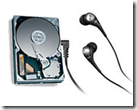
What should I do for a noisy hard disc drive?
 All of our new Parallel ATA (PATA) hard drives and new Serial ATA (SATA) hard drives are optimized for performance, we do not have a utility that can quiet them down.
All of our new Parallel ATA (PATA) hard drives and new Serial ATA (SATA) hard drives are optimized for performance, we do not have a utility that can quiet them down.
While modern drives are extremely quiet, every disc drive makes a certain amount of noise while running. Normally, the faster the drive motor spins, the higher pitched the resulting sound will be.
It is also normal for the drive to make sort of a “chattering” or “clicking” sound while it is reading and writing data.
However, if the sound coming from the area around your drive has recently changed or is an excessive grinding or clanking noise, this may indicate a physical problem with the drive.
Noise from the cooling fans in the power supply are often mistaken as hard drive noise. To isolate whether the noise is coming from the drive or one of the fans, you can issue a “spin down” command through software. The Seagate SeaTools for DOS diagnostic has an acoustical spin down test.
If the sound goes away, then the sound was produced by the drive. If the sound remains, then the drive is not the cause of the sound.


